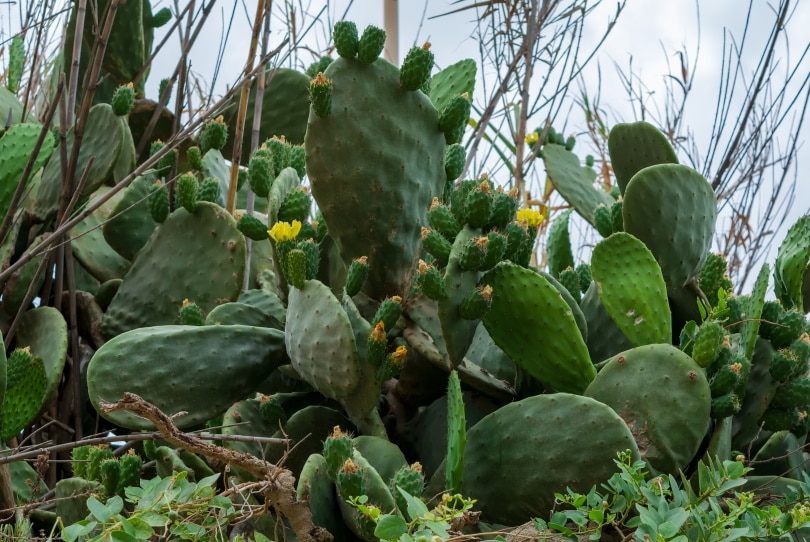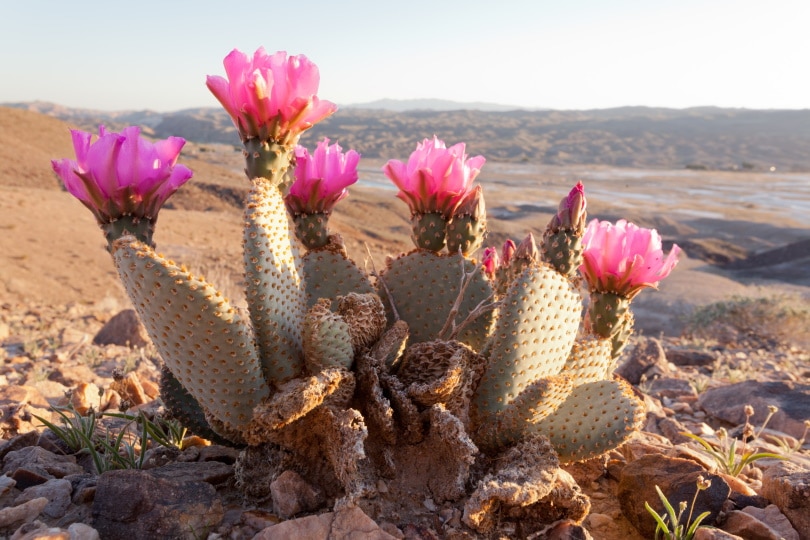16 Different Types of Prickly Pear Cactus (With Pictures)
-
Pete Ortiz
- Last updated:

The prickly pear cactus, or opuntia cactus, is a genus of flowering cactus in the shape of a pear, hence their common name. There are dozens of varieties of prickly pears, with many found in deserts of the United States and some grown as ornamentals in homes and other buildings. Prickly cacti can hybridize, which means they cross with other species of prickly pear, and new hybrid species are being discovered.
Although opuntia cacti do not have spines in the traditional sense, they have glochids, which can appear fluffy but are incredibly unpleasant to the touch. Below are 16 of the most common types of prickly pear cactus, including those with edible fruits, called tunas, that are turned into candy and jam.
The 16 Different Types of Prickly Pear Cactus
1. Bearded Prickly Pear
| Scientific name: | Opuntia strigil |
| Location: | Chihuahua Desert |
| Height: | 3 feet |
| Flower Color: | Cream |
| Fruit Color: | Red |
The bearded prickly pear grows to a height of approximately 3 feet, and its plentiful brown spines can appear quite disorderly. The plant grows at elevations of up to 4,000 feet and has cream or pale yellow flowers with small, bright red fruit.
2. Beavertail

| Scientific name: | Opuntia basilaris |
| Location: | Mojave |
| Height: | 18 inches |
| Flower Color: | Rose |
| Fruit Color: | Brown |
The beavertail prickly pear is easily recognized for its bright pink flowers and beavertail-shaped pads. It grows to around 1.5 feet tall and flourishes in some of the driest and hottest deserts in the US and Mexico. Growers need to replicate those conditions with little to no water, which makes propagation a challenge in some climates.
3. Blind Prickly Pear
| Scientific name: | Opuntia rufida |
| Location: | Chihuahua desert |
| Height: | 6 feet |
| Flower Color: | Yellow to orange |
| Fruit Color: | Red |
The blind prickly pear is a trunked cactus with several branches. The plant can grow 6 feet tall but more commonly attains a height of 5 feet. It has circular pads with short spines. Flowers start bright yellow and fade to orange as they age, and the fruit is approximately 1 inch long and red.
4. Brown-Spined Prickly Pear
| Scientific name: | Opuntia phaeacantha |
| Location: | Gobi Desert |
| Height: | 3 feet |
| Flower Color: | Yellow |
| Fruit Color: | Red or purple |
The brown-spined prickly pear, also known as the tulip prickly pear, grows approximately 3 feet tall. Their bright yellow flowers are attractive and easy to care for. It prefers hot and dry conditions but can survive the occasional frost, unlike other opuntias.
5. Engelmann’s Prickly Pear
| Scientific name: | Opuntia engelmannii |
| Location: | Chihuahua desert |
| Height: | 5 feet |
| Flower Color: | Yellow |
| Fruit Color: | Red or purple |
Native to California, Arizona, Texas, and northern Mexico, the Engelmann’s prickly pear is a reasonably fast-growing cactus that can grow 5 feet tall and 15 feet wide, which makes it a good choice for filling spaces in a desert garden. Also known as the tulip prickly pear, the plant will grow bright yellow flowers every year with edible fruits that appear red to purple.
6. Hedgehog Prickly Pear
| Scientific name: | Opuntia erinacea |
| Location: | Mojave |
| Height: | 18 inches |
| Flower Color: | Yellow or pink |
| Fruit Color: | Red |
The hedgehog prickly pear, which also goes by the Mojave or grizzly bear prickly cactus, is recognized for its dense accumulation of spines. Some of the thicker spines point downwards while long, thin spines point upwards, and this nonuniform arrangement can give the plant a somewhat shaggy appearance.
It is another prickly cactus species that is frost tolerant, and it has yellow flowers with green fruits that have a red tinge to them.
7. Indian Fig Prickly Pear
| Scientific name: | Opuntia ficus indica |
| Location: | Southern and Central America |
| Height: | 16 feet |
| Flower Color: | Yellow |
| Fruit Color: | Red |
The Indian fig prickly pear is a fast-growing prickly pear found throughout the US and Mexico. It can grow to a height of 15 feet or more and has yellow flowers and edible red fruits. The plant requires and needs minimal watering, and its fast-growing nature makes it popular in gardens.
8. Pancake Prickly Pear
| Scientific name: | Opuntia chlorotica |
| Location: | Mojave |
| Height: | 7 feet |
| Flower Color: | Yellow and red |
| Fruit Color: | Purple |
The pancake prickly pear gets its name from its circular pancake-shaped pads with a bluish color. The plant will grow to 7 feet and produce yellow flowers with a red center. The fruit is fleshy and purple, and the pancake prickly pear is found in the Mojave and the Sonoran desert.
9. Plains Prickly Pear
| Scientific name: | Opuntia polycantha |
| Location: | Mojave, Sonoran, Chihuahua deserts |
| Height: | 1 foot |
| Flower Color: | Orange |
| Fruit Color: | Brown |
The plains prickly pear is commonly seen in Nebraska but can grow in many climates across the US. It has shallow roots, which means it can be susceptible to heavy rainfall but also allow it to catch what little rain does fall in its habitat more easily. It is a relatively small species, growing to just 12 inches in height, and it produces orange flowers with tan-colored fruit.
10. Purple Prickly Pear
| Scientific name: | Opuntia violacea |
| Location: | Chihuahua desert |
| Height: | 4 feet |
| Flower Color: | Yellow |
| Fruit Color: | Green |
The purple prickly pear gets its name from the attractive color of its pads rather than its flowers, which present as yellow, or its fruit, which are green. The pads appear green under normal conditions but take on a purple tinge in cool and dry conditions. The cactus does well in full sun and requires minimal watering when it is established.
11. Purple-Fruited Prickly Pear
| Scientific name: | Opuntia phaeacantha |
| Location: | Chihuahua desert |
| Height: | 3 feet |
| Flower Color: | Yellow |
| Fruit Color: | Purple |
The purple-fruited prickly pear, or New Mexico prickly pear, grows in sandy soils and can thrive in rocky conditions. Its flowers are yellow with a red center, and its fruit is purple, hence its name. The cactus blooms from March to May and is pollinated by insects.
12. Santa Rita Prickly Pear
| Scientific name: | Opuntia violacea |
| Location: | Chihuahua desert |
| Height: | 6 feet |
| Flower Color: | Yellow |
| Fruit Color: | Green |
The Santa Rita prickly pear is a beautiful cactus often grown as an ornamental plant. It has round pads that change color from gray to purple and back again over the year. The pads are purple when the temperature is cold and change to gray again in summer.
13. Smooth Prickly Pear
| Scientific name: | Opuntia humifusa |
| Location: | Great Basin |
| Height: | 2 feet |
| Flower Color: | Yellow |
| Fruit Color: | Green |
The smooth prickly pear is one of few species of prickly pear that tends to grow with no spines. It can grow 2 feet tall, produces yellow flowers with some red, and bears somewhat unremarkable fruit.
14. Spiny-Fruited Prickly Pear
| Scientific name: | Opuntia spinusbacca |
| Location: | Chihuahua desert |
| Height: | 4 feet |
| Flower Color: | Orange |
| Fruit Color: | Green |
The spiny-fruited prickly pear grows approximately 4 feet tall and is common in the Chihuahua Desert. It produces yellow flowers with red bases, and its fruit is yellow-green but is most remarkable because the fruits are, like the plant itself, covered in spines.
15. Texas Prickly Pear
| Scientific name: | Opuntia lindheimeri |
| Location: | Texas |
| Height: | 5 feet |
| Flower Color: | Yellow |
| Fruit Color: | Purple |
Named for the fact that it is commonly found in regions of Texas, the Texas prickly pear forms in thickets and can achieve a height of 5 feet. It has a central trunk but can lay flat rather than upright. The Texas prickly pear has yellow flowers and purple fruits.
16. Tuberous Prickly Pear
| Scientific name: | Opuntia macrorhiza |
| Location: | Sonoran desert |
| Height: | 6 inches |
| Flower Color: | Yellow or red |
| Fruit Color: | Red |
The tuberous prickly pear is a slow-growing cactus that will not usually reach 1 foot tall. It has large tubular roots, and the plant has yellow flowers with a red base and spineless, red fruit.
Conclusion
The prickly pear is, in most cases, a genus of spiny cactus that is flowering and produces fruit. They are cultivated for their edible fruits, which, in some cases, can be eaten raw and are often turned into candy and other foods. Above are 16 of the most common and popular prickly pear species, many of which can flourish in gardens or indoor pots, as well as in deserts and arid regions.
Featured Image Credit: Lena Maximova, Shutterstock
Contents


